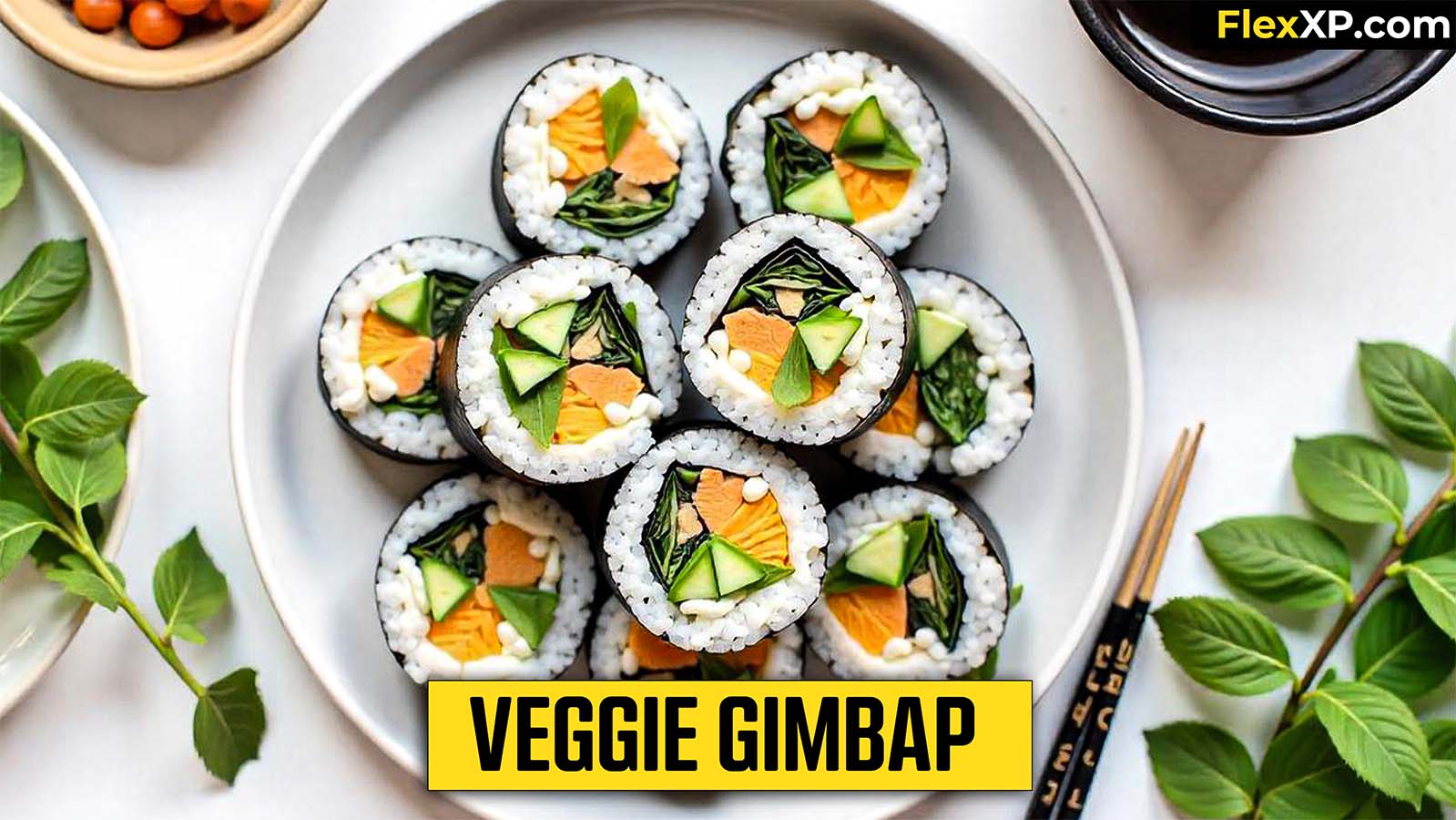Veggie Gimbap Recipe

Written By: Stella Petra
Updated: May 28, 2025

Veggie Gimbap is a vibrant Korean-style rice roll packed with colorful vegetables and seasoned rice, all wrapped in roasted seaweed. It’s a clean, balanced meal that’s light yet filling—perfect for lunch, meal prep, or a grab-and-go snack. With no meat or dairy, this plant-based version is high in fiber, naturally gluten-free, and packed with nutrients, all rolled into one satisfying bite.
- 2 cups cooked short-grain rice
- 1 tablespoon sesame oil
- ½ teaspoon salt
- 4 sheets roasted seaweed (nori)
- 1 medium carrot, julienned
- 1 small cucumber, julienned (seeds removed)
- 1 cup baby spinach
- 4 strips pickled radish (danmuji)
- 1 egg, beaten (optional for ovo-vegetarians)
- 1 teaspoon oil (for cooking)
- Toasted sesame seeds for garnish
Main Ingredients
Instructions
- Step 1: Start by preparing your fillings. Julienne the carrot and cucumber. Sauté the carrots in a pan with a pinch of salt for 2-3 minutes until slightly tender. Blanch spinach in hot water for 30 seconds, rinse under cold water, squeeze out excess moisture, and season with a touch of sesame oil and salt.
- Step 2: If using egg, heat a small pan with a little oil and pour in the beaten egg to form a thin omelet. Cook for 1-2 minutes per side, then slice into long strips.
- Step 3: In a large bowl, mix the cooked rice with sesame oil and salt. Let it cool slightly before handling.
- Step 4: Place a sheet of seaweed shiny side down on a bamboo rolling mat. Spread about ½ cup of rice evenly over the bottom ¾ of the seaweed, leaving the top part clear.
- Step 5: Layer the spinach, carrots, cucumber, pickled radish, and egg strips (if using) horizontally across the center of the rice.
- Step 6: Use the bamboo mat to tightly roll the gimbap away from you, applying gentle pressure to keep it firm. Dab water along the top edge to seal the roll.
- Step 7: Repeat with remaining ingredients. Slice each roll into 6-8 pieces using a sharp knife lightly coated in sesame oil. Sprinkle with toasted sesame seeds and serve with soy sauce or dipping sauce of choice.
Notes
- Gimbap is highly customizable—add avocado, tofu, or bell peppers for variation.
- Use brown rice or cauliflower rice for different nutritional profiles.
- Rolling may take practice—don’t overfill the roll to keep it tight and neat.
- Great for bento boxes and stays fresh for up to 24 hours when stored in the fridge.
- Use tamari or coconut aminos for a gluten-free dipping sauce.
Frequently Asked Questions
Can I make this without a bamboo mat?
+Yes. Use parchment paper or a clean kitchen towel to help roll the gimbap.
Is gimbap eaten cold or warm?
+It’s typically served at room temperature or slightly chilled—perfect for on-the-go meals.
Can I add protein to make it more filling?
+Add strips of baked tofu or tempeh for an extra plant-based protein boost.
What’s the difference between gimbap and sushi?
+Gimbap uses sesame oil-seasoned rice and doesn’t typically include raw fish, while sushi rice is seasoned with vinegar.
How do I keep it from falling apart?
+Roll tightly, avoid overfilling, and let the roll rest for a few minutes before slicing with a sharp oiled knife.
Don’t Wish for It, Work for It – Join the FlexXP Newsletter Today!
Thank you for signing up for the FlexXP Newsletter!
This site is protected and the Google Privacy Policy and Terms of Service apply.